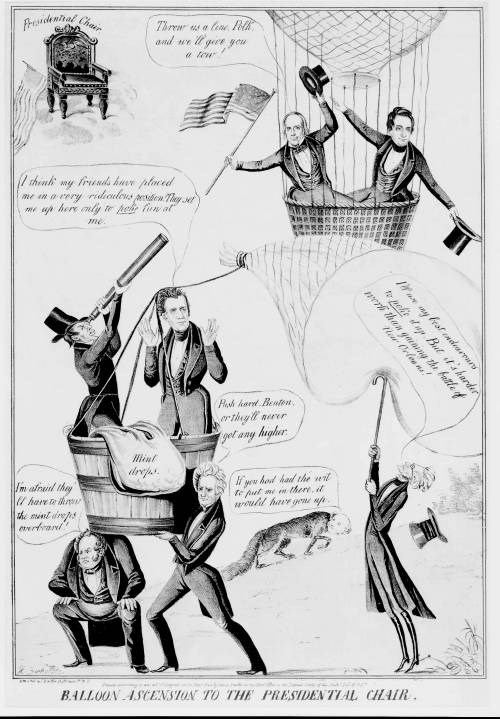
Library of Congress Setting the StageMartin Van Buren spent a bit of time establishing his home and farm at Lindenwald following his defeat in 1840. He then set his sights on a return to Washington, D.C. in 1844. President William H. Harrison had died one month after inauguration and John Tyler became the tenth president. The White House was beset by conflict as President Tyler vetoed all but two of the bills introduced by the Whig Party leaders. Agreement was reached to repeal the Subtreasury Act passed during the Van Buren administration but not on the reestablishment of a central bank. (Niven, page 502). Increasing government deficits were addressed with a new tariff bill to replace the one passed during Andrew Jackson’s administration.As early as 1842, the stage was set for competition between the Whigs, led by Henry Clay, and the Democrats, led by Martin Van Buren. Clay resigned from the Senate seat he had held since 1831 in order to organize the Whig Party and seek the presidential nomination. Martin Van Buren traveled through the south and west between February and July 1842, exploring the possibility of a Democratic nomination. The Little Magician practiced his craft along the route, visiting Andrew Jackson at The Hermitage and James K. Polk at his home in Columbia, Tennessee, and accepting an invitation from Henry Clay to visit Ashland in Lexington, Kentucky. Texas statehood became the main question following these months of travel. Privately within his inner circle, Van Buren opposed Texas coming into the Union as a state where slavery would be allowed. Support of Northern Democrats for Van Buren hinged on the containment of plantation slavery. Southern Democrats began to question Van Buren’s motives. A letter from Missouri Senator Jabez Hammond compelled Van Buren to make his opposition public, even if doing so might cost him the nomination. The Democratic ConventionThe Democratic convention was held in late May in Baltimore, MD. A majority of delegates supported Van Buren, but not enough to satisfy the two-thirds rule that had been waived in 1836 and 1840 and was supported in 1844 due to political maneuvering by John C. Calhoun’s men. Lewis Cass (a member of Andrew Jackson’s cabinet) and Richard Mentor Johnson (who had been Van Buren’s vice president) were among the top three considered for nomination as the number of ballots rose to seven. To avoid a division of the Democratic Party as votes for Van Buren and Cass were close, James K. Polk was added to the eighth ballot as Johnson withdrew his name. Van Buren’s name was withdrawn on the ninth ballot, and New York cast all its votes but one for Polk for the sake of party unity. Other delegates followed suit, and Polk accepted the Democratic nomination as the first dark horse candidate.The election was held between November 1 and December 4, 1844. Fifty percent of the popular vote was cast for James K. Polk. Henry Clay received forty-eight percent of the popular vote. 38,175 popular votes separated the two candidates. James G. Birney received 62,300 popular votes and 0 electoral votes for the Liberty Party, which was the first third party ever to be included in election totals. Polk was elected the eleventh U.S. President with 170 electoral votes from 15 states, winning against Henry Clay who received 105 electoral votes from 11 states. Polk made clear his intention to serve one term as the U.S. President and kept that commitment, paving the way for an exciting election cycle in 1848! |
Last updated: September 18, 2022
